 |
| a home away from home |
| HOME FEEDBACK TELL A FRIEND WEB SITE DESIGN CAREER WITH US CONTACT US |
![]() Festivals
Festivals
![]() Durga
Puja
Durga
Puja
![]() Associations
Associations
![]() Learn
Bangla
Learn
Bangla
![]() Beng.
Marriage
Beng.
Marriage
![]() Baby's
Name
Baby's
Name
![]() Art
& Craft
Art
& Craft
![]() Great
Indians
Great
Indians
![]() Beauty
Care
Beauty
Care
![]() Recipe
Recipe
![]() Astrology
Astrology
![]() Beng.
Section
Beng.
Section
![]() Bengal
Bengal
![]() Calcutta
Calcutta
![]() Tiger
Tiger
![]() Beng.
Calendar
Beng.
Calendar
![]() Wallpapers
Wallpapers
![]() Movie
Movie
![]() Music
Music
![]() E-Card
E-Card
![]() Shopping
Shopping
![]() E-Puja
Room
E-Puja
Room
![]() News
News
![]() E-mail
E-mail
![]() Month's
Events
Month's
Events
![]() Weather
Weather
![]() Chat
Chat
![]() Travel
Travel
![]() Join
Us
Join
Us
![]() Advertise
Advertise
![]() Website links
Website links
![]() Link
to us
Link
to us
![]() Guest
Corner
Guest
Corner
![]() Services
Services
![]() WebSite
Design
WebSite
Design
| Kali is regarded as one of the principal deities of Bengal. Kali is a powerful and complex Goddess with multiple forms. The Divine can be manifested in many different forms, with various roles and personalities. According to legend, not withstanding her husband Shiva’s insult by her father Daksha, Sati jumped into fire and gave her life. Enraged by this mishap, Shiva went wild. To pacify Him,Vishnu decimated the body of Sati with his chakra into 51 different parts. The body parts fell all over the Indian subcontinent. The places where the body parts fell – have become centres of worship of the Goddess in different manifestations. There are 51 of those and they are called Shakti Peethas. Some of them are in West Bengal. | |
| Sage Vasishtha had seen this form and worshipped goddess Sati in the form of Tara. Tara is no one but Maa Kali. Maa Kali is fiery and violent, has four hands and blood drips from Her tongue. Kali temples are found in numbers all over India. Hindus all over the world worship Maa Kali in various forms. Some of the famous Kali temples are at Kalighat, Dakshineshwar, Tarapith etc. The great devotees of Maa Kali, namely Ramkrishna, Bamakhepa etc used to worship Maa Kali in these Kali temples. The Kali temples draw immense attraction during the festive times, especially during Kali Puja. | |
| KALIGHAT TEMPLE (Shakti Peeth) - Kali Temple | |
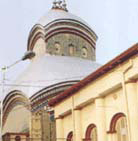 |
According to a scripture called "Pithamala's Nigamatantra" the vast bow shaped land stretching from Dakshineshwer to Bahulapur i.e. Behala is the Kalikhetra or realm of Kali. The core triangular region, approximately 1 krosha have Brahma, Vishnu and Shiva on the three inner corners and Devi Kalika at its center. Nakuleshwar Bhairava and Ganges remains side by side at this shrine........more |
| DAKSHINESHWAR TEMPLE - Kali Temple | |
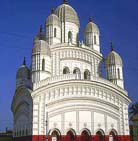 |
Dakshineshwar in Hooghly district is known for its Kaali temple, made famous through its association with Ramakrishna Paramahamsa, the spiritual Guru of the religious leader Swami Vivekananda. Queen Rasmani the renowned queen of Janbazar, was the founder of this temple. In the year 1847, dreamed the wealthy widow Rani Rasmani dreamed the Divine Mother, in the form of the goddess Kali. She appeared to the Rani in a dream.....more |
| TARAPITH TEMPLE (Shakti Peeth) | |
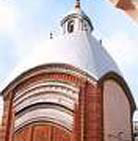 |
Tarapith is a small temple town in Birbhum district of West Bengal, India. This town is famous for the temple which lies there in. The temple is dedicated to Goddess Tara, a fearsome form of the Divine shakti. Tarapith derives its name from the fact that it is the most important centre of Tara worship, Famous Kali devotee Bamakhepa used to worship in this very temple and resided in the crematory which is adjacent to the temple..... more |
| KAMAKHYA TEMPLE (Shakti Peeth) | |
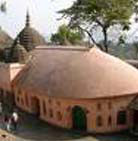 |
Kamakhya is a Shakti Peeth temple. It is situated at the top of the Nilachal hill, at about 800 meters above the sea level. It is located in the western part of Guwahati, a city in Assam, India. The entire temple complex consists of many other temples along with Kamakhya. But this one is the main temple. It is a very popular pilgrimage destination for Hindu and Tantric worshippers....more |
| MAHAKALIKA TEMPLE | |
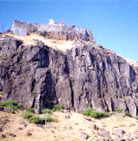 |
Maa Mahakalika temple, Pawagadh is one of the biggest tourist and pilgrimage centers in the dynamic state of Gujarat which attract lakhs of tourists and pilgrims every year and tops the list of educational institutions' excursion programmes. From the city of Baroda, at a distance of 45 kms, the old town of Pawagadh is located. The entire area is mainly forest land and very charming. On the hill top, the ancient famous temple of Mahakalika is located. It is believed to be one of the 51 Shakti Peeths. The right toe of |
| Goddess Kalika fell here. On the ground floor of the temple is Shakti Peeth and idol of Goddess Kali visited by Hindus and on the roof of the building is a Mazar of a Peer, visited by Muslim devotees. In the same structure, two places of worship stand and two sets of devotees visit them in perfect peace and harmony, a unique distinction indeed. Goddess Mahakalika has been fulfilling wishes of millions of devotees for thousands of years. |
|
| KARNI MATA TEMPLE | |
 |
The Karni Mata temple, 30 kms from Bikaner, is dedicated to an early fifteenth century mystic who was considered to be a reincarnation of goddess Durga. The specialty of the temple is that it is inhabited by legions of brown rats which scurry around the complex without any fear. The rats are believed to be repositories of the souls of dead charans, the traditional bards. Bikaner's ruler Ganga Singh had the whole temple built in marble. The domes of the temple are made of silver and gold. The mandap and the panels above the image are also golden. |
| Devotees place offerings in silver and gold when their prayers are answered.The elaborate works on the main gate of the temple is a tribute to the fine craftsmanship of the artisans of those days. On the occasion of Navratri, this temple hosts a fair which attracts hordes of pilgrims from places far the near. | |
| KALKAJI TEMPLE | |
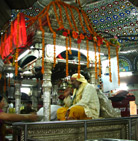 |
Situated in Nehru Place (New Delhi), Kalkaji Temple is a very old temple and the oldest part was built up in 1764 A.D. The Kali Temple in Kalkaji boasts of an existence of 3,000 years, although the oldest surviving portion of it dates to 1764-1771 when the Marathas were in power. Kalkaji temple dedicated to the Goddess Kalka Devi. Kalkaji mandir is very famous and has numerous devotees thronging it on many religious occasions, throughout the year. Small red flags decorate the temple then, and women outnumber men among the devotees. Folklore is replete with tales of the Kalkaji temple, so much so that one does not know where legend ends and history begins. |
| CHAMUNDA DEVI TEMPLE | |
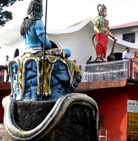 |
Chamunda Devi is a Shakti shrine, 10 km west of Palampur, on the Baner River. This colourful shrine has a wrathful form of Durga or Chamunda. The idol in the temple is considered so sacred that it is completely hidden beneath a red cloth. It is situated on the bank of Ban Ganga. With all the natural surroundings ideally suited for meditation prayers and spiritual attainments. This was the cremation ground for 22 villages and supposed to be a place which gives solace, spiritual attainments in the form of Mahakali Chamunda. Here Lord shiva is present in the form of death, destruction & dead bodies along with Devi Chamunda. Devotees offer prayers, worship and give |
| offerings for their ancestors. It is thought to be sacred to take a dip in Ban Ganga and to read and recite the writings of Shat Chandi. In the old days, people used to offer sacrifices also to the deity. Kanyas (unmarried baby girls) are worshiped. Also Lord shiva is worshiped with Holy water from Ban Ganga. | |
| JWALAMUKHI TEMPLE | |
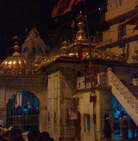 |
Recognized as one of the 51 Shaktipithas of India, the Jwalamukhi Devi Temple, tended by the followers of Goraknath, is set against a cliff. The picturesque temple, built in the Indo-Sikh style, is a modern building whose dome is of gilt, gold and pinnacles and possesses a beautiful folding door of silver plates, presented by the Sikh Raja Kharak Singh. Dedicated to the "Goddess of Light", the Jwalamukhi temple is one of the most popular Hindu temples in Northern India. The temple located on a small spur on the Dharamshala-Shimla road at a distance of about 20-kms from the Jwalamukhi Road Railway Station attracts lakhs of pilgrims every year. |
| In this temple there is a copper pipe through which natural gas comes out. After Daksha Yoga Bhagna, Lord Shiva placed the burnt dead body of Sati on his shoulders and started wandering about in a state of madness. To save the world from the destructive wrath of Lord Shiva, Lord Vishnu started cutting the limbs of the dead Goddess Parvati one by one. The places where they fell became sacred centers for the worship of Shakti. The tongue of Sati fell at the place where the temple of Jwalamukhi is situated. The flames that come out of the openings in the earth’s surface are regarded as the manifestations of the fallen tongue of Sati and are worshipped as “Jwalamukhi Devi” (Goddess, who emits flames from her mouth). | |
GREAT INDIANS || BENGALI SECTION || BENGALI MARRIAGE || BABY'S NAME || WALLPAPER || BENGAL || WEATHER || TRAVEL
MOBILE WALLPAPER || E-CARD || MOVIE || WEBSITE LINKS || ASSOCIATIONS || SHOPPING || ASTROLOGY || MUSIC || BEAUTY CARE
TIGER || NEWS || GUEST CORNER || FEEDBACK || LINK TO US || FOR ADVERTISING || SERVICES || CONTACT || BENGALI CALENDAR
Graphics, Sound or content copied or produced in part or whole in any media will be illegal.
Persons or websites caught using our material will be penalized.
Privacy Statement || Copyright
Copyright ©1999-2019 BANGALINET.COM






